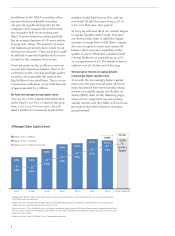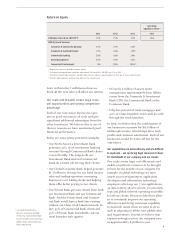JP Morgan Chase 2013 Annual Report Download - page 10
Download and view the complete annual report
Please find page 10 of the 2013 JP Morgan Chase annual report below. You can navigate through the pages in the report by either clicking on the pages listed below, or by using the keyword search tool below to find specific information within the annual report.-
 1
1 -
 2
2 -
 3
3 -
 4
4 -
 5
5 -
 6
6 -
 7
7 -
 8
8 -
 9
9 -
 10
10 -
 11
11 -
 12
12 -
 13
13 -
 14
14 -
 15
15 -
 16
16 -
 17
17 -
 18
18 -
 19
19 -
 20
20 -
 21
21 -
 22
22 -
 23
23 -
 24
24 -
 25
25 -
 26
26 -
 27
27 -
 28
28 -
 29
29 -
 30
30 -
 31
31 -
 32
32 -
 33
33 -
 34
34 -
 35
35 -
 36
36 -
 37
37 -
 38
38 -
 39
39 -
 40
40 -
 41
41 -
 42
42 -
 43
43 -
 44
44 -
 45
45 -
 46
46 -
 47
47 -
 48
48 -
 49
49 -
 50
50 -
 51
51 -
 52
52 -
 53
53 -
 54
54 -
 55
55 -
 56
56 -
 57
57 -
 58
58 -
 59
59 -
 60
60 -
 61
61 -
 62
62 -
 63
63 -
 64
64 -
 65
65 -
 66
66 -
 67
67 -
 68
68 -
 69
69 -
 70
70 -
 71
71 -
 72
72 -
 73
73 -
 74
74 -
 75
75 -
 76
76 -
 77
77 -
 78
78 -
 79
79 -
 80
80 -
 81
81 -
 82
82 -
 83
83 -
 84
84 -
 85
85 -
 86
86 -
 87
87 -
 88
88 -
 89
89 -
 90
90 -
 91
91 -
 92
92 -
 93
93 -
 94
94 -
 95
95 -
 96
96 -
 97
97 -
 98
98 -
 99
99 -
 100
100 -
 101
101 -
 102
102 -
 103
103 -
 104
104 -
 105
105 -
 106
106 -
 107
107 -
 108
108 -
 109
109 -
 110
110 -
 111
111 -
 112
112 -
 113
113 -
 114
114 -
 115
115 -
 116
116 -
 117
117 -
 118
118 -
 119
119 -
 120
120 -
 121
121 -
 122
122 -
 123
123 -
 124
124 -
 125
125 -
 126
126 -
 127
127 -
 128
128 -
 129
129 -
 130
130 -
 131
131 -
 132
132 -
 133
133 -
 134
134 -
 135
135 -
 136
136 -
 137
137 -
 138
138 -
 139
139 -
 140
140 -
 141
141 -
 142
142 -
 143
143 -
 144
144 -
 145
145 -
 146
146 -
 147
147 -
 148
148 -
 149
149 -
 150
150 -
 151
151 -
 152
152 -
 153
153 -
 154
154 -
 155
155 -
 156
156 -
 157
157 -
 158
158 -
 159
159 -
 160
160 -
 161
161 -
 162
162 -
 163
163 -
 164
164 -
 165
165 -
 166
166 -
 167
167 -
 168
168 -
 169
169 -
 170
170 -
 171
171 -
 172
172 -
 173
173 -
 174
174 -
 175
175 -
 176
176 -
 177
177 -
 178
178 -
 179
179 -
 180
180 -
 181
181 -
 182
182 -
 183
183 -
 184
184 -
 185
185 -
 186
186 -
 187
187 -
 188
188 -
 189
189 -
 190
190 -
 191
191 -
 192
192 -
 193
193 -
 194
194 -
 195
195 -
 196
196 -
 197
197 -
 198
198 -
 199
199 -
 200
200 -
 201
201 -
 202
202 -
 203
203 -
 204
204 -
 205
205 -
 206
206 -
 207
207 -
 208
208 -
 209
209 -
 210
210 -
 211
211 -
 212
212 -
 213
213 -
 214
214 -
 215
215 -
 216
216 -
 217
217 -
 218
218 -
 219
219 -
 220
220 -
 221
221 -
 222
222 -
 223
223 -
 224
224 -
 225
225 -
 226
226 -
 227
227 -
 228
228 -
 229
229 -
 230
230 -
 231
231 -
 232
232 -
 233
233 -
 234
234 -
 235
235 -
 236
236 -
 237
237 -
 238
238 -
 239
239 -
 240
240 -
 241
241 -
 242
242 -
 243
243 -
 244
244 -
 245
245 -
 246
246 -
 247
247 -
 248
248 -
 249
249 -
 250
250 -
 251
251 -
 252
252 -
 253
253 -
 254
254 -
 255
255 -
 256
256 -
 257
257 -
 258
258 -
 259
259 -
 260
260 -
 261
261 -
 262
262 -
 263
263 -
 264
264 -
 265
265 -
 266
266 -
 267
267 -
 268
268 -
 269
269 -
 270
270 -
 271
271 -
 272
272 -
 273
273 -
 274
274 -
 275
275 -
 276
276 -
 277
277 -
 278
278 -
 279
279 -
 280
280 -
 281
281 -
 282
282 -
 283
283 -
 284
284 -
 285
285 -
 286
286 -
 287
287 -
 288
288 -
 289
289 -
 290
290 -
 291
291 -
 292
292 -
 293
293 -
 294
294 -
 295
295 -
 296
296 -
 297
297 -
 298
298 -
 299
299 -
 300
300 -
 301
301 -
 302
302 -
 303
303 -
 304
304 -
 305
305 -
 306
306 -
 307
307 -
 308
308 -
 309
309 -
 310
310 -
 311
311 -
 312
312 -
 313
313 -
 314
314 -
 315
315 -
 316
316 -
 317
317 -
 318
318 -
 319
319 -
 320
320 -
 321
321 -
 322
322 -
 323
323 -
 324
324 -
 325
325 -
 326
326 -
 327
327 -
 328
328 -
 329
329 -
 330
330 -
 331
331 -
 332
332 -
 333
333 -
 334
334 -
 335
335 -
 336
336 -
 337
337 -
 338
338 -
 339
339 -
 340
340 -
 341
341 -
 342
342 -
 343
343 -
 344
344
 |
 |

88
In addition to the HQLA securities, other
unencumbered marketable securities
can provide significant liquidity for the
company. (This category does not include
any securities held in our trading port-
folio.) Our investment securities portfolio
has an average duration of 2.8 years and an
average AA+ rating. The majority of securi-
ties balances presented above reside in our
investment securities. These securities could
be utilized to provide liquidity and a source
of cash for the company if necessary.
Our total assets are $2.4 trillion so you can
see just how liquid our balance sheet is. As
a reference point, our cash and high-quality
securities are essentially the same as the
$740 billion of our total loans. This is a very
conservative utilization of our total deposits
of approximately $1.3 trillion.
We have increasingly strong capital ratios
You can see on the capital chart below that
under Basel I, our Tier 1 Common has gone
from 7.0% to 10.7% from 2007–2013 (if
Basel I had been consistently applied, that
number would have been 11.8%), and our
new Basel III ratio has gone from 5.0% to
9.5% over that same time period.
In 2014, we will meet all of our current targets
in capital, liquidity and leverage. One ratio
not shown in the chart is called the Supple-
mentary Leverage Ratio (SLR) that is, simply,
the ratio of equity to assets and certain o-
balance sheet exposures, regardless of the
quality of assets. While that calculation still
is being finalized, we currently are at 4.6%
vs. a requirement of 5%. We intend to have a
cushion over 5% by the end of this year.
We have good returns on capital despite
increasingly higher capital ratios
Even with the increasingly higher capital
ratios over the past several years, all of our
main businesses have been earning strong
returns on tangible equity (see Return on
Equity (ROE) chart on the following page).
Some of our competitors are not earning
similar returns, and they likely will feel more
pressure to alter their business strategies
going forward.
JPMorgan Chase Capital Levels
2014 Projection2013201220112010200920082007
Basel I Tier 1 Common
Basel III Tier 1 Common1
Basel I Tier 1 Common Projection3
7.0% 7.0%
9.8% 10.1%
11.0%
9.5% 10.0% +
Target4
8.7%
11.8%2
12.3%
7.9%
7.0%
6.4%
4.7%
5.0%
10.7% 11.3%
8.8%
1 Through 2013, Basel III capital ratios reflect the firm’s best estimate based on its understanding of the rules in the relevant period
(2007-2008 ratios are pro forma)
2 Reflects the firm’s estimated Basel I capital ratio, excluding the impact on the firm’s positions as of December 31, 2013 of Basel 2.5
market-risk rules, which became eective January 1, 2013
3 Eective January 1, 2014, the Basel I ratio is no longer a regulatory capital measure. The ratios shown reflect an approximation of what
the firm’s Basel I capital ratio would be as of December 31, 2014, both including and excluding the impact of Basel 2.5 market-risk rules,
were Basel I still in eect
4 Reflects the firm’s stated 2014 Basel III Tier 1 Common ratio objective
